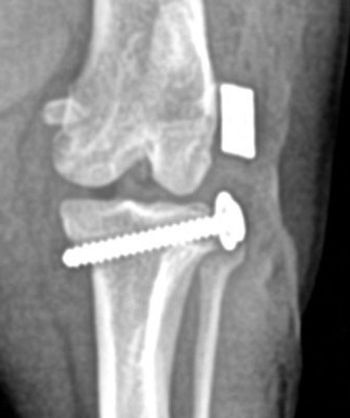
- dvm360 May-June 2025
- Volume 56
- Issue 3
Shih tzu recovers from leg injury using a pouch implant
The 5-year-old canine's left hind leg was treated after experiencing vehicular trauma.
On March 3, 2025, a 5-year-old male neutered shih tzu was brought to Amboy Veterinary Clinic in Amboy, Illinois, immediately for vehicular trauma on his left hind leg. Toni L. Trego, DVM, owner of the clinic, stated in a case study regarding the patient that, remarkably, no bony injuries were identified in the patient. However, the patient’s skin extending from just proximal to the hock down to his toes was avulsed from the underlying tissue. The team at the clinic approached the patient with conservative management, including a drain, bandage, oral antibiotics, and pain medication, but all of the affected skin sloughed. A week after the patient arrived at the clinic, the veterinary team obtained a culture during debridement on March 10.
On March 12, a pouch flap was created on the left body wall, and the left hind leg was inserted into the flap and sutured into place with a fenestrated drain and a 10-mL Vetlen Pouch—the first time that Trego had used the product.
“[Vetlen] actually offered a free sample, and I had signed up for that online...so it’s been sitting in my clinic for quite a while, and then this case came along. I thought at first that we might be able to use it within the wound, but then it was clear that all the skin was necrotic. So then when I decided to make the pouch flap, it’s like, 'I know this is going to need antibiotics, there’s no question,'” Trego said in an interview with dvm360.
Through the pouch, the patient was initially given ceftiofur sodium 50 mg, up to 9 mL total volume with 0.9% sodium chloride from March 12 to 21. A culture was then performed that revealed multidrug-resistant Enterococcus faecium along with Streptococcus canis and Staphylococcus schleiferi. The result of culture findings led the doctors to switch the patient to vancomycin hydrochloride 30 mg, up to 6 mL total volume with 0.9% sodium chloride from March 22 to April 1.
The drain was removed from the patient on March 15, and an antibiotic treatment was administered through the pouch. The client had disclosed to the team that administering oral medication to the patient had been a challenge for them, so they were grateful to discontinue oral antibiotics once the switch to vancomycin was made.
The flap of skin from the patient was excised from the donor site and closed over the left distal limb on April 2; the Vetlen Pouch was then removed and discarded. The team noted that parts of the flap became necrotic and sloughed, but the majority survived with only small areas of open granulating wounds remaining. The patient has made progress healing, and the client is delighted with the results of the ordeal.
Trego explained to dvm360 that normally, being a small practice in a rural town, she would refer emergencies out. However, that was not in the client’s budget in this case, so she decided to try the Vetlen Pouch to make it work for the client and is now looking forward to trying the product out on one of her larger animal patients. Trego explained that after this case, she would recommend this product to other veterinary professionals and offered some advice on how to use the product.
“I wouldn’t hesitate to recommend it. I would say [to] read all the directions. I think it was very advantageous to us to have a culture so we knew what antibiotic to use. I mean, that’s just good antibiotic stewardship to begin with. But there is a limited list of antibiotics that diffuse well through the pouch, so getting that culture so you’re on target would be really helpful,” Trego said. “As far as ease of use goes, it’s great.”
Articles in this issue
5 months ago
Renovate to revitalize5 months ago
Decision-making for colic workup in the field5 months ago
Overcoming understaffing5 months ago
When clients lie about preventive dosingNewsletter
From exam room tips to practice management insights, get trusted veterinary news delivered straight to your inbox—subscribe to dvm360.




